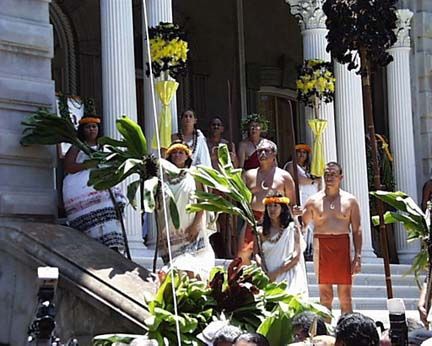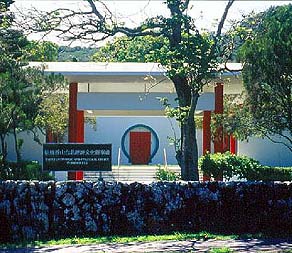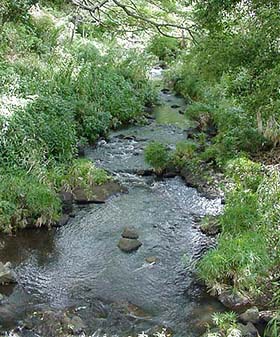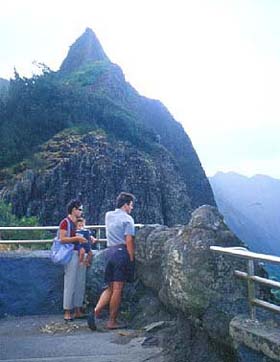 |
 |
 |
|||||||||||||||||||||
|
|
|
|
|
|
|
|
|
||||||||||||||||
|
|
|||||||||||||||||||||||
|
|
|
|
|
"The heart of Hawaiian culture, I think, is ‘ohana (family) and the idea of aloha, and food. That the land will provide all the things we need for healthy families," Stephen suggests. "Well, those are core values. How you use it today is changing because of technology. "Taro is also a symbol, it’s not necessarily going to be like, 'Well, we can’t re-establish ahupua‘a if we can’t get our taro lands back.' I don’t think that’s necessarily the limiting factor. I think what is key is the water. How much you can get back into taro I don’t know, because we’re certainly not going to dig up graveyards to put taro back. There are social limits to what will be accepted as restoration. I don’t think Nu‘uanu, except in the upper reaches, will be able to say, oh, we can go back to taro. And the activities in the harbor preclude any serious fishing, which would have been there." So what does it mean to replant and cultivate Hawaiian culture in Nu‘uanu?
|
||
|
|
||
|
"I think more its about a value system: restoring the sense of dignity to Nu‘uanu that was once an ali‘i stronghold, once a seat for international diplomacy. I think those are still part of the mana of the place. This has strong mana of the ali‘i. Strong mana of the nations that signed treaties with the Kingdom. I think this is the evolved Nu‘uanu -- not necessarily taro. Taro will be the reality for a lot of the Ko‘olau ahupua‘a and the neighbor islands. "At the same time, the whole concept of ahupua‘a is linked to water, and the issue of water quality. This is directly linked to the fact that the highest quality, the maintenance of water quality was essential for food production, because of the food relationship to health. It’s encapsulated in the phrase, ka wai ola o Kane, the waters of life, the life-giving and the link to food. Western language separates these out, but they really are all connected."
|
|
|
|
The integrity of the water and the ecosystem within the ahupua‘a is affected by alien plant species. Stephen points out, "A lot of these alien plants are coming down from houses above, which probably have nice gardens, but allow for the escape of what we call fugitive, alien plants -- they move into the natural landscape and take over. "There’s a lot that would miss the eye of people that would stop by and say, ''Wow, beautiful Hawai‘i, what are you guys complaining about?' We have a lot to complain about, in terms of the devastation that’s taken place to the ecosystem. "Restoring native plants is like applying herbal treatment to your body. What’s the condition? What’s the herb? You prescribe it. That’s what we’re talking about when we say, 'What kind of plant should go here to treat the water?' So the analogy of the body is a metaphor for the ‘aina. I don’t doubt that the ancient Hawaiians knew this, they knew those secrets. And the Hawaiian herbalists would ask, 'Okay, well what part of your body ails you?' and would then go out into the ahupua’a to find the plant that would treat that. "I think this is more than a metaphor. Western science is beginning to understand it’s not just a metaphor, it’s a reality. Our bodies are evolved from the land. This is where the bridge is being built across the so-called spiritual divide that keeps us from relating."
|
|
|
|
|
"There’s a global market for environmental restoration. And indigenous peoples could become major players in that market. Westerners might try to sell the Chinese a solution, but can you imagine a Hawaiian team going in and saying, 'We have a culture that is similar to yours. We have values similar to yours. Here’s a Hawaiian solution that’s an answer to your problem'? "We need to recover that sense that, we’re not simply talking about not polluting. We’re talking about taking care of our bodies, when we take care of the land. And vice versa. When you go out and work in the lo‘i you’re actually giving the ‘aina a lomi lomi (massage). the movement, the clearing of the land, the removal of alien species. Those are all equivalent to the various treatments we give like an herbal bath, or a massage, or all those health treatments. It’s too obvious!"
|
||
|
|
||
|
"Tourists are up here, and they think oh this is nice and green. But if the tourists knew the real story -- that it’s all phony, full of non-native species -- think of what they would do. Or if conversely we actually restored it, think of what that would do for the tourism industry. People would come here and say, 'Wow, Hawaiian culture is still alive.' "We’re even at the point of a movement they call 'volunteer tourism' which actually offers tour packages that say, 'Come and spend the day and help us replant our native plants. We’ll take you to these special places, things that aren’t in the guide book and work with the community, learn about Hawaiian culture, Hawaiian traditions and help restore the ahupua‘a.' "That's the sort of emerging vision we want to see for Hawai‘i. A place where Hawaiian culture is alive. I call it the living ahupua‘a."
|
|
|
|
|
|
"I think simply adapting many of our cultural ways to theirs in procedure is not going to be the answer," adds Kalani. "It’s actually going to have to be a real change. That’s what the stories impart to me. They impart the values of the place -- that it’s not something on paper, either paper by degree, by proclamation, or paper money. It’s the value in this breeze that says, 'This is a certain kind of breeze, and when we get that rain, it’s really a greeting.' "And if you change this valley, you alter the patterns of the airflow. And you will get another kind of wind or rain, and maybe the Hawaiians will have a name for it, but it will be a grieving kind , or it will be a storm wind, and you’ll only get storms with your rain instead, because you have changed this. But that’s what I believe they impart."
|
||
|
|
||
| |
| |
|
|
 |
| Nu‘uanu Home | Map Library | Site Map | Hawaiian Islands Home | Pacific Worlds Home |
|
|
|||
| Copyright 2003 Pacific Worlds & Associates • Usage Policy • Webmaster |
|||








